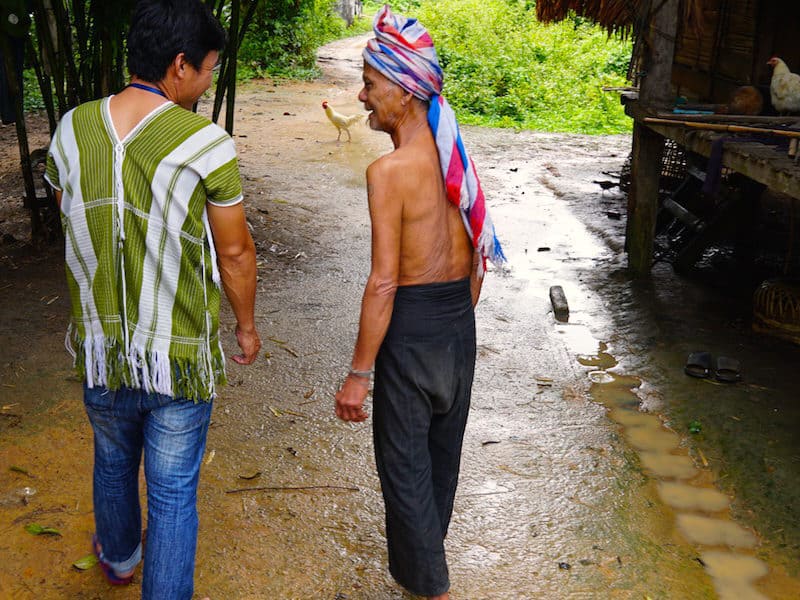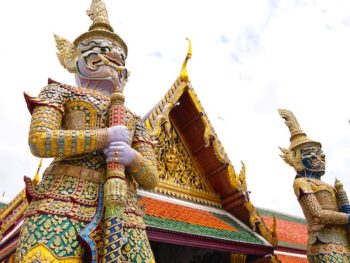Get To Know The Hill Tribes of Thailand
updated 5/30/19
Visiting Different Hilltribe Communities of Thailand
Since we only had one day, we booked the one day private tour with Thailand Hilltribe Holidays. The reason we chose this organization instead of others, is they ensure the tribes benefit from tourism, working at the local level allowing visitors to interact in an ethical and responsible manner with the tribes. Our tour started with a pick-up from our hotel, and about an hour drive into the countryside.
They use a 4×4 to get you through the less paved roads. Our Guide Anan, is a Karin tribe member, he gave us a detailed understanding of what life is like in the Karin tribes and why it is important to him to help sustain this way of life. When Anan is not giving tours, he is working the farms of his village.

The Hilltribe Baan Tong Luang village Community

Our first stop was to a community consisting of multiple hilltribes. Here we had to pay an entrance fee and were taken to see a variety of tribes living together; Long neck, Palong, Mien, Hmong, Karen, Akha and Lisu hilltribes.

While it felt a bit contrived, we found out that this is a way they support their tribes.You can come and buy some of their goods, observe their lifestyle all so you can sustain their way of life–something I am happy to help support.Our kids did get a chance to interact with some of the members; learning to shoot an arrow from a wooden cross-bow like contraption, grinding dried rice to make rice flower and watching a Long-Neck woman weave from a traditional weaving machine. Our kids chased chickens and were given a close-up view and explanation of a rice paddy field and how to harvest rice.

A Family Reunion Pig-Roast with Hmong Tribe
We drove to an Hmong village, small about an hour out where we had just left, covering roads that were not well maintained and looking out for more water buffalo and the white, “skinny” cows of Thailand along the way. When we arrived to the village, it wasn’t what I expected at all. The streets were somewhat paved, and most of the households owned a car or motorcycle or both. The homes, shops and other structures were mostly made out of cinder block, cement and tin siding or roofing with dirt floors.
As we pulled up and exited the car, the kids ran off chasing chickens and were immediately invited to play soccer with some of the local kids in the street. The language barrier didn’t seem to matter; they took right to playing with each other.

Anan took us to a home that was celebrating a family reunion, roasting a pig and drinking beer. We were invited in to see what a typical home looked like. Not much: a dirt floor, an open fire, a sink with not-great plumbing and a sleeping area. Extremely basic and modest, which made us appreciate everything we had. The men were cooking the pig and offered my husband some assorted barbecued organs.

He accepted with pleasure, as Iwaited outside with the women, watching my kids chase more chickens. The women were all fussing over my daughters blonde hair, and kept holding her hand and smiling. While my daughter said she felt weird, I explained that, in this case, it was okay. We went and bought beer to thank the family for their hospitality. Now, they offered my husband pieces of the prized pig’s ear, he was happy to accept. We said our goodbyes, thanked the tribesmen/women and headed back to the van.
Bamboo Huts, Thatched Roofs
Two more hours driving along unpaved roads and deep jungle brought us to a Karin tribe, deep off the beaten path in Thailand. As we approached, the first thing the kids noticed was the animals living under the homes raised up on bamboo stilts. Each family had buffalo, pigs, and chickens right under their living quarters.

We were taken into one of the elders homes and shown the sleeping quarters and the living area. It was verybasic two room home, with bamboo walls, woven mats on the floor, and a thatched roof above. As were were about to leave, the monsoon rains kicked it with fierce winds and a downpour. We sat in silence as the kids looked out the holes in the walls, watching the rains drive the mud throughout the walkway. The Karin elder offered us freshly harvested honey in a cup. He then showed us how to eat his fermented tea leaves. The moment was so relaxing; no electronics, just silence and the consistent patter of rain hitting the roof.

Once the rains let up, we traveled along the village a bit more, learned their way of life and observed more. Kids used the “outhouse.” There, they discovered a squat toilet for the first time, and using a bucket to flush the toilet. While they talked about if for a while, there was a lesson: that not all homes have plumbing, electricity, modern conveniences.

It was the bamboo huts, the mudfloors, the women with heavy rings stretching their necks and the squat toilets that made the kids appreciate that not everyone lives with the conveniences of the modern world, nor does everyone want to live with the modern conveniences.
Our day was a great introduction to the Hill Tribes of Thailand. If we had we more time, maybe we would have done a homestay, which is also offered. I recommend a day or more with Hilltribe Holidays, as a powerful and beautiful way for kids to immerse themselves in different cultures, to learn that not everyone lives like we do, and to learn that language has no borders when it come to food and play.
There are many responsible ways to travel throughout Thailand. Riding Elephants and petting overly sedated tigers just to get the perfect photo are not ones I recommend. If you are interested in how to ethically see Elephants in Thailand, then don’t miss the Elephant Nature Park. Located close to Chiang May and offers many different, responsible visiting options.
Like It? Pin It!







 Negev Desert Adventures: 7 Awesome Things To Do In The Negev Desert, Israel
Negev Desert Adventures: 7 Awesome Things To Do In The Negev Desert, Israel








Wow, I love learning about different cultures and the way of life. it is certainly fascinating
Thanks for sharing your adventure and experience with a company that ensures the tribes benefit rather than exploit. We’re planning to visit Thailand in a few months and always love learning new cultures and customs. We’ll definitely save this post to reference when making our itinerary!